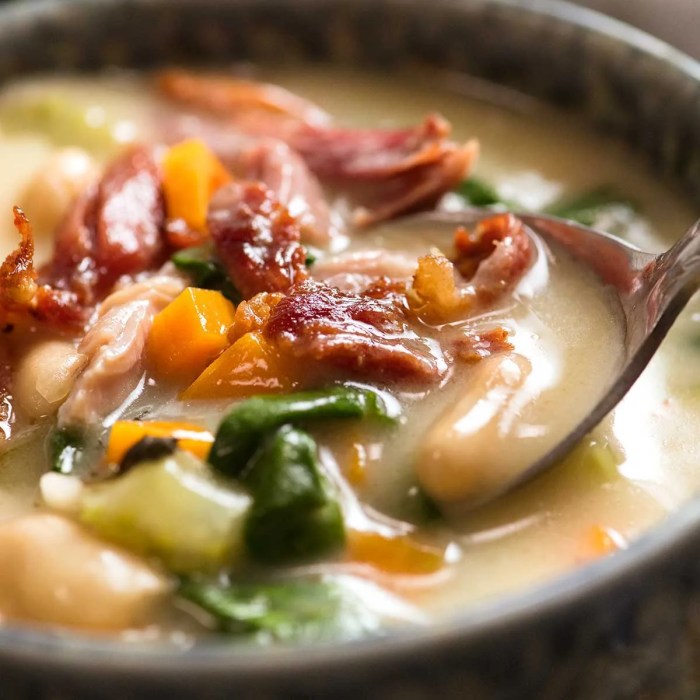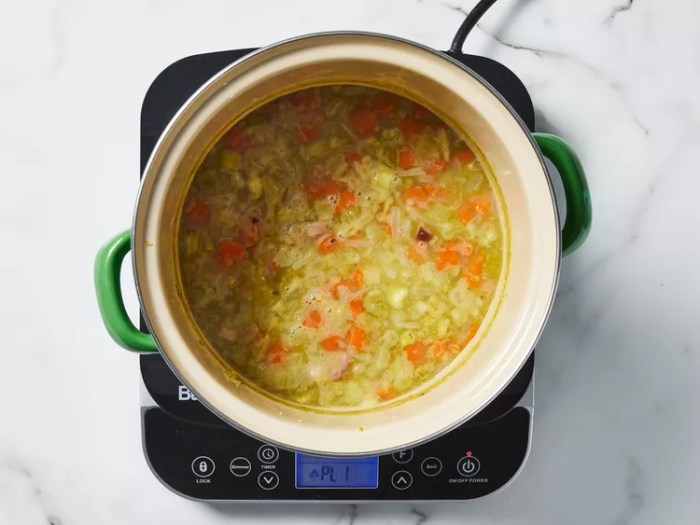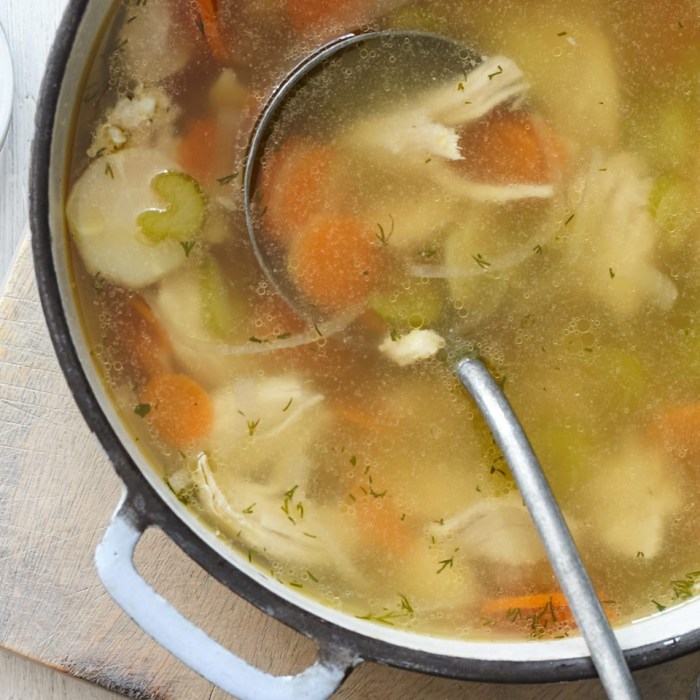Ham Bone Pea Soup: A Rich and Flavorful Recipe: Recipe For Pea Soup Using A Ham Bone
Recipe for pea soup using a ham bone – This recipe elevates the classic pea soup by incorporating a ham bone, resulting in a deeply flavorful and surprisingly nutritious meal. The ham bone imparts a savory richness that complements the sweetness of the peas, creating a complex and satisfying taste experience. This soup is not just delicious; it’s also a great source of protein and essential vitamins.
Ham Bone Pea Soup: Flavor Profile and Nutritional Benefits, Recipe for pea soup using a ham bone
The addition of a ham bone significantly enhances the pea soup’s flavor profile. The bone releases collagen and savory compounds into the broth, creating a rich, umami depth that elevates the overall taste. This contrasts beautifully with the natural sweetness of the peas. Furthermore, the ham bone contributes a substantial amount of protein to the soup, making it a hearty and satisfying meal.
The peas themselves are a good source of vitamins A and K, fiber, and iron, further boosting the nutritional value of this dish.
Ingredient Selection and Preparation
Choosing the right ingredients is crucial for a successful pea soup. The following list details the necessary components and preparation steps.
- 1 large ham bone (about 2-3 pounds), preferably with some meat still attached
- 1 cup dried green peas (or 2 cups frozen peas, or 3 cups fresh peas, adjust water accordingly)
- 2 carrots, peeled and chopped
- 2 celery stalks, chopped
- 1 large onion, chopped
- 8 cups water or vegetable broth
- Salt and pepper to taste
- Optional: 1 bay leaf, sprigs of fresh thyme or marjoram
Begin by rinsing the ham bone thoroughly under cold water. If necessary, pre-boil the ham bone for about 15 minutes to remove any impurities. This step is optional but recommended. For the vegetables, roughly chop the carrots, celery, and onion to allow for even cooking and maximum flavor extraction during the simmering process.
Cooking Methods and Procedures
The following steps Artikel the cooking process for creating a flavorful and well-balanced ham bone pea soup. Adjust simmering time based on the type of peas used.
- In a large stockpot, combine the ham bone, chopped vegetables, water (or broth), bay leaf (if using), and thyme or marjoram (if using). Bring to a boil.
- Reduce heat to low, cover, and simmer for at least 1 hour, or until the vegetables are tender. Add dried peas after 30 minutes of simmering. For frozen peas, add them during the last 15 minutes of cooking. Fresh peas should be added during the last 10 minutes.
- Remove the ham bone from the pot and let it cool slightly. Remove as much meat as possible from the bone and shred it. Return the shredded ham to the soup.
- Using an immersion blender (or carefully transferring portions to a regular blender), partially puree the soup to achieve your desired consistency. For a thicker soup, puree more of the mixture; for a brothy soup, puree less or not at all.
- Season with salt and pepper to taste.
Careful monitoring of cooking time is crucial to prevent overcooking the peas, which can result in a mushy texture. Similarly, prolonged simmering with the ham bone ensures maximum flavor extraction.
Variations and Flavor Enhancements
This basic recipe offers a foundation for numerous variations. Experimenting with different herbs and spices can dramatically alter the soup’s flavor profile.
- Smoked Paprika Variation: Add 1 teaspoon of smoked paprika along with the other vegetables for a smoky depth.
- Garlic and Herb Variation: Include 2-3 cloves of minced garlic with the onions and add a mix of fresh herbs like thyme, rosemary, and parsley.
- Creamy Variation: Stir in a splash of heavy cream or coconut cream (for a vegan option) at the end of cooking for added richness and creaminess.
Vegetarian adaptations can be achieved by substituting the ham bone with vegetable broth enriched with dried mushrooms or a strong vegetable bouillon cube for umami flavor. Vegan adaptations require omitting the ham bone entirely and using a rich vegetable broth.
Serving Suggestions and Presentation

Source: recipetineats.com
This hearty soup can be served in various ways, each offering a unique culinary experience.
| Serving Style | Accompaniments | Temperature | Description |
|---|---|---|---|
| Main Course | Crust bread, salad | Hot | A complete and satisfying meal. |
| Side Dish | Grilled cheese sandwich | Warm | A comforting complement to other dishes. |
| Light Lunch | A dollop of plain yogurt or crème fraîche | Warm | A lighter, yet still flavorful meal option. |
| Appetizer | Small crusty bread | Warm | A flavorful starter for a larger meal. |
Garnish the soup with fresh herbs like parsley or chives, croutons, or a swirl of cream for an enhanced visual appeal. A sprinkle of freshly cracked black pepper adds a final touch of elegance.
- Crust bread
- Grilled cheese sandwich
- Salad
- Plain yogurt or crème fraîche
Storage and Reheating

Source: tasteofhome.com
Proper storage is essential for maintaining the soup’s quality and freshness. Leftover soup should be stored in airtight containers in the refrigerator for up to 3 days. For longer storage, freeze the soup in airtight containers for up to 3 months.
When reheating, gently warm the soup on the stovetop or in the microwave, avoiding rapid boiling, which can make the soup watery. Stir occasionally to ensure even heating and prevent scorching.
Illustrative Descriptions

Source: howtocook-guide.com
As the soup simmers, a fragrant aroma fills the kitchen—a harmonious blend of earthy peas and savory ham, enhanced by subtle herbal notes. The finished soup boasts a velvety smooth texture, with tender peas and a rich, flavorful broth. The color is a vibrant green, punctuated by the flecks of shredded ham and the bright green of any fresh herb garnish.
Questions and Answers
Can I use a different type of bone?
While a ham bone provides the best flavor, you can experiment with other smoked or cured bones for a similar effect, though the taste will differ.
How long can I store leftover soup?
Leftover soup can be stored in the refrigerator for up to 4 days or frozen for up to 3 months.
What if my soup is too thick/thin?
Add broth or water to thin the soup, or simmer uncovered for a longer period to thicken it. You can also blend a portion for a creamier consistency.
Are there any substitutions for the vegetables?
Feel free to substitute other root vegetables like turnips or parsnips for carrots or add different types of onions for variation in flavor.


